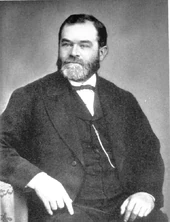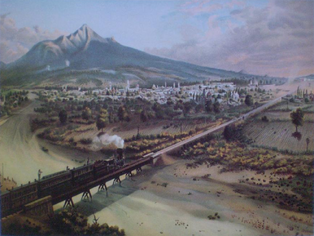A railroad is a transportation system for passengers and goods in which a train of cars is pulled along a set of rails by an engine. Railroads were first developed in Great Britain as an outgrowth of James Watt's late 18th century steam engines. In the early 19th century, special high-pressure steam engines were invented that were suitable for use as railroad engines.
Railroads in the C.N.A.[]

Railroad engine and cars.
The first railroads in the Confederation of North America appeared in the Northern Confederation in the early 1820s, and are credited with boosting the N.C.'s economy. Railroads in the N.C. were initially financed from London, but soon banks in New York City were also investing in them. Entrepreneurs built lines throughout the N.C., and by 1831 railroad branches were extending into the Southern Confederation and Indiana, with Michigan City serving as a railroad terminus in 1836. The most notable of the early railroad tycoons was Cornelius Vanderbilt, head of the Northern Confederation Central Railroad, which had lines going to Michigan City in the west, Portland, Massachusetts in the north, and Norfolk, Virginia to the south.

Cornelius Vanderbilt of the Northern Confederation.
During his first year as Governor-General in 1843, Winfield Scott helped bring about the formation of the New York, Michigan City, and Pitt Railroad, which was designed to connect the major cities of the C.N.A. through a system of feeders. In 1852, the C.N.A. surpassed Great Britain in railroad production. A railroad line connected the Manitoban capital of North City with Port Superior in 1855.
A second wave of railroad building took place in the C.N.A. after the Rocky Mountain War. By 1880, Thomas Scott's Grand National Railroad controlled some 18,000 miles of track, while his rival Andrew Carnegie's North American United line controlled another 22,000 miles. Carnegie was the first to introduce sleeping and eating cars, air brakes, and carriage feeders; Scott, meanwhile, was responsible for refrigerated cars, automatic switches, and the rationalization of gauges in 1878. At the same time, an Irish immigrant named Patrick Gallivan became the president of the Indiana Northern Railroad in 1861, and began extending its lines into Manitoba to the northwest, and later to Southern Vandalia and the United States of Mexico.

Patrick Gallivan of Indiana.
The C.N.A.'s railroads gave rise to the great labor unions of the 1860s, with railroad engineers forming the Consolidated Engineering Fraternity in 1857. This was followed by unions of switchmen, yardmen, and dispatchers. These unions came together with unions from the steel industry and dockworkers to form the Mechanics National Union in 1874 under the leadership of Michael Harter of the Yardmen.
One of the founding principles of the People's Coalition in their 1869 Norfolk Resolves was that the C.N.A.'s railroads, turnpikes and canals should be placed under the control of a state agency that would determine rates. During his first term as Governor-General, John McDowell of the Liberal Party sought to co-opt the reform movement by passing the Railroad Control Commission Act in 1878. The Act created the Railroad Control Commission, which had the power to investigate complaints and make recommendations for rate adjustments. McDowell also passed the Williamson Anti-Monopoly Act, which gave the Minister for Home Affairs the right to prosecute any large corporation or railroad "engaged in unfair or unethical practices." Later, Governor-General Henderson Dewey, as part of what he called his "dismantling operation" in the 1920s, passed the Transportation Control Act, which placed railroads, airmobile lines, and interconfederation truckers under the authority of the Confederation Transportation Authority.
The C.N.A.'s railroad network continued to expand into the 20th century. By 1910, every population center of more than 10,000 inhabitants was within fifteen miles of a railroad, and sleeping cars were available for all who could afford them.
Railroads in the U.S.M.[]
The U.S.M. did not initially take part in the railroad boom, since President Andrew Jackson hated the "iron monsters", and opposed their construction. However, with the discovery of gold in California in 1838, Jackson was finally forced to concede the need for a railroad.

Jefferson & California Railroad.
A group of French and Jeffersonian businessmen organized the Jefferson & California Railroad soon after the discovery of gold, and received government support in the form of land grants and subsidies. The first rails were laid in Henrytown, Jefferson on 4 February 1839, while a second crew began construction from San Francisco, California on 11 April. French engineers supervised construction at both ends, and French iron and steel was imported to build the rails and steam locomotives of the railroad.
The building of the J & C Railroad sparked a transportation boom in Mexico, leading to the formation of other railroad and steamship firms. However, this boom seems to have been aborted by the coming of the Rocky Mountain War with the C.N.A. in 1845. The completion of the J & C Railroad in 1848 provided California's only rail link with the rest of the U.S.M. This proved inadequate as California's agricultural sector surpassed mining as its primary economic activity after the end of the war in 1855. In 1865, twenty-six wealthy businessmen in San Francisco formed a consortium called Kramer Associates in order to "explore means by which the system of transportation within California, and between California and the rest of the world, might be bettered." K.A. initially invested in railroads, dry goods, and canning, and the consortium seems to have been the primary factor in creating a postwar railroad boom. Within ten years of its formation, the U.S.M. had the highest number of railroad miles per capita in the world.
Following his re-election in the 1875 Mexican elections, President Omar Kinkaid began a program to bring Mexico's large corporations, including its railroads, under greater government control. In 1876 Kinkaid was able to gain passage of the Thomas Railroad Reform Act, which placed the lines under a government commission which set rates and determined future expansion.
K.A. was able to gain control of the J & C Railroad through the law firm of Bigham & Wilkes, which served as general counsel for the railroad. The firm's senior partner, Egbert Wilkes, was able to place his protege Benito Hermión on the railroad's Board of Directors in 1879, and by the following year Hermión had become President of the J & C Railroad. In 1880 Hermión was placed in command of the U.S.M.'s newly-formed national police force, the Constabulary, and in September 1881 he was able to make himself dictator of Mexico. Kramer Associates began its expansion beyond the U.S.M. in 1891 with several international projects, including the construction of a railroad network in Manchuria.
One of Mexican President Vincent Mercator's social reforms of the 1950s and 1960s was the lowering of railroad charges on a sliding scale. By 1968, passage on Mexican railroads was free.
Sources[]
Sobel's sources for the railroad include David Gould's Gold and Railroads, Profits and Losses (Mexico City, 1948); Robert Small's The Role of the Railroad in the History of the Northern Confederation (Mexico City, 1960); and John Flaherty's Builders of North America (London, 1967).
This was the Featured Article for the week of 10 November 2013.
